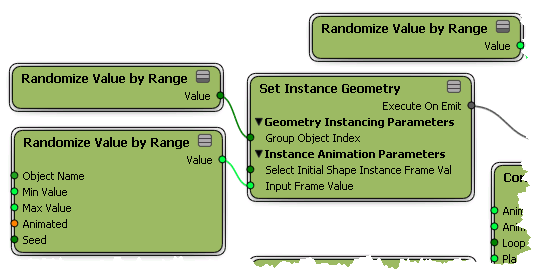You can instantiate animated objects as particles. This animation can be either deformation or transformations, however, each type of animation requires a specific setup:
If the geometry of the master object is animated (shape animation or a deformation), the instanced particles will inherit that deformation when you select the master object and set the Hierarchy Mode to be Object Only.
If the master object's local transformations are directly animated, that animation is not used for the instances if you select it and set the Hierarchy Mode to be Object Only. However, if you select the parent as the master object to be instanced, each instance inherits any animation in that hierarchy because the children's transformations are relative to their parent — see below for how to do this.
Create a hierarchy or model that includes the objects whose local transformations are animated.
Follow the steps in Creating Particle Instances for setting up the ICE tree.
Open the Instance Shape node or Set Instance Geometry compound property editor.
Select the parent object of the hierarchy or the model as the master object to instantiate.
To work with the animation of the instances, see Controlling the Instance's Animation.
For information on rendering animated instances, see Rendering Particle Instances.
Here are several tips that can help when using animated instances:
You can randomly select which frame of the instance's animation is used as a starting frame for each particle by plugging in a Randomize Value by Range compound into the Input Frame Value port on the Set Instance Geometry compound. In the Randomize Value by Range property editor, select the range of animation from which a frame can be selected.

You may also want to add some turbulence to the instance's movement by using a Turbulize compound, such as Turbulize Velocity. Plug its Execute output into a port on the ICE Tree node.
To keep particles aligned along a certain vector as they're moving, use the Align on Velocity compound. Plug its Execute output into a port on the ICE Tree node. See Aligning Particles along a Velocity Vector for information.
Try to keep the amount of animated instances to a smaller number because there can be issues when rendering them. See Rendering Particle Instances for more information.
Each instance's local time is shown in viewport by default so that you can see the instance's animation. However, for performance reasons, you can choose to display a lower percentage of the instance animation in the Particle Display property editor (see Setting the Particle Display).
Set the value for the Animation Detail % parameter in this property editor:
A value of 0% does not evaluate each instance at different times, but the instance is still animated: it draws all instances at the same (current) frame. This makes playback faster.
A value of 100% displays each instance at its local instance time (rounded to the nearest frame), which can slow things down.
Any value between 0 and 100 is evaluated using a heuristic that tries to group instance animation times together to minimize evaluation, and tries to draw each instance at its closest time.
 Except where otherwise noted, this work is licensed under a Creative Commons Attribution-NonCommercial-ShareAlike 3.0 Unported License
Except where otherwise noted, this work is licensed under a Creative Commons Attribution-NonCommercial-ShareAlike 3.0 Unported License